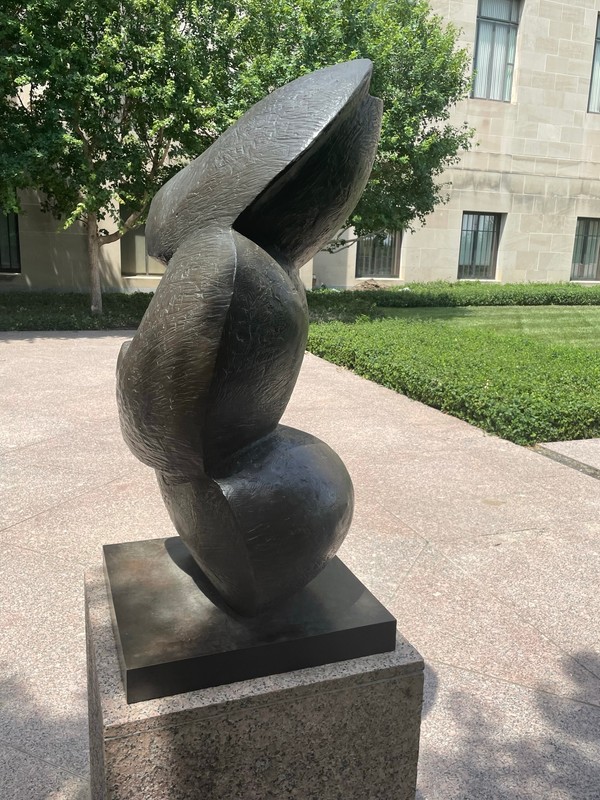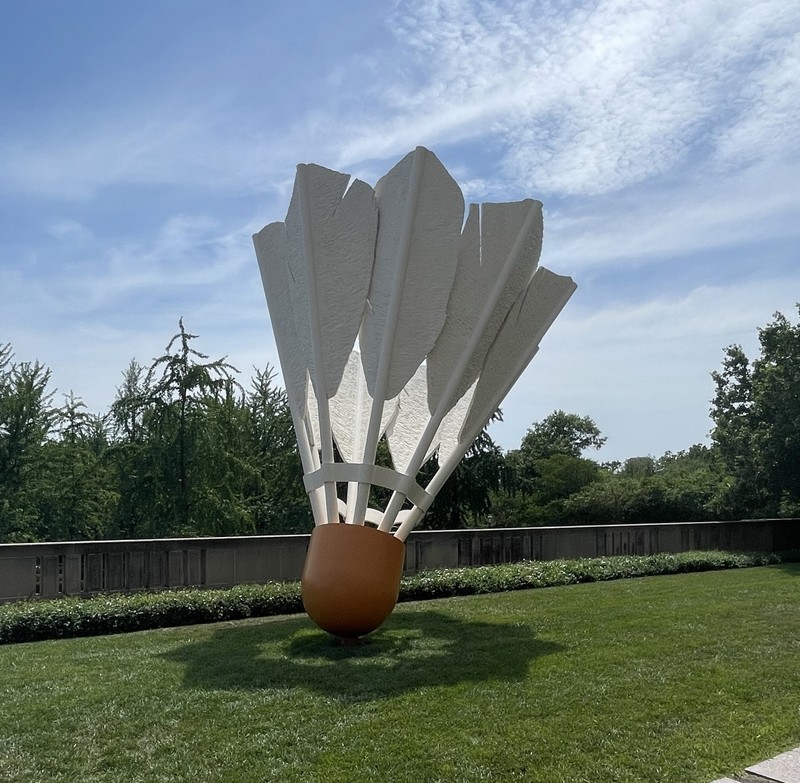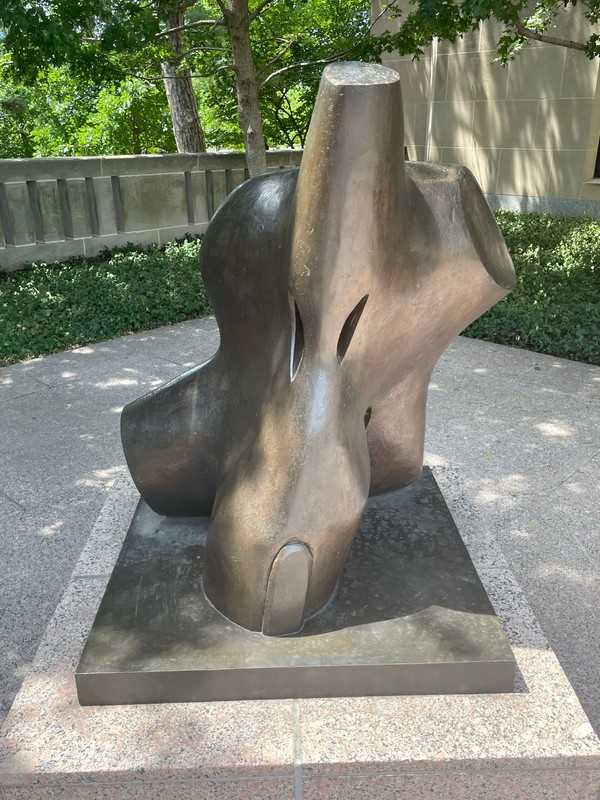Three Part Object, Torso, and Shuttlecock
Introduction
Text-to-speech Audio
The southwest terrace of the Nelson-Atkins Museum of Art features three works, one of four iconic Shuttlecocks (1994) by Claes Oldenburg and Coosje van Bruggen and two bronze sculptures by Henry Moore, Torso (1967) and Three Part Object (1960). The two bronze Moore pieces seen here were gifted to the Nelson-Atkins Museum of Art by the Hall Family Foundation. English artist Henry Moore is best known for his sculptures using human form. As an artist who grew up in the countryside of Yorkshire and lived his adult life in rural Hertfordshire, he was also inspired by the landscape and often used references of nature in his work. Into the 60s, he started experimenting with more abstract, ambiguous forms. While some of these forms are more compact and dense in silhouette, they still exhibit a sense of movement which was more distinct in his previous works. Moore described the progression of his work as, “becoming less representational, less outwardly a visual copy, and so what some people would call more abstract; but only because in this way I can present the human psychological context of my work with the greatest clearness and intensity.”
Images
Three Part Object by Henry Spencer Moore

Shuttlecock

Torso by Henry Spencer Moore

Backstory and Context
Text-to-speech Audio
Best known for using the human form in his artwork, Henry Moore created Three Part Object employing an insect-like design. It features three biomorphic segments that balance on one another at an angle, creating a C-shape depending on the viewing angle. The bottom form is more spherical while the top two segments are recessed and contain an angular protrusion. Created in 1960, Three Part Object is an early example of work in the era that Henry Moore was experimenting with and increasing the level of abstraction in his sculpting.
Gallery Label
“Henry Moore observed that "Three-Part Object is a strange work, even for me. Three similar forms are balanced at angles to each other. In my mind it has a connection with insect life, possibly centipedes. Each segment has a leg, and there is an element in the sculpture nearer to an animal organism than a human one."
Torso
Created in 1967, Torso is an example of the compact, abstract form that Moore implemented in his work in the 60s. The bronze evokes a living form, though it is open to interpretation by each viewer based on their own experiences, as seen in much of Moore’s work.
Gallery Label
“Torso is an ambiguous, organic abstraction that evokes human, animal and other natural forms. It is as much a portrayal of massive tree limbs as it is a rendition of the body. Moore said: "Trunks of trees are very human. A branch that comes out from the main trunk is like an arm coming out from a body."
Shuttlecock
One of four 19-foot tall shuttlecock sculptures created by Claes Oldenburg and Coosje van Bruggen in 1994. The sculptures were commissioned by The Nelson through the generosity of the Sosland Family.
Gallery Label
“The husband and wife team of Claes Oldenburg and Coosje van Bruggen were commissioned in 1994 to design a sculpture for The Nelson-Atkins Museum of Art. They responded to the formality of the original neoclassical building and the green expanse of its lawn by imagining the Museum as a badminton net and the lawn as a playing field. The pair designed four birdies or shuttlecocks that were placed as though they had just landed on opposite sides of the net. Each shuttlecock weighs 5,500 pounds, stands nearly 18 feet tall and has a diameter of some 16 feet.”
Sources
Three Part Object, The Nelson-Atkins Museum of Art. Accessed September 7th, 2022. https://art.nelson-atkins.org/objects/14125/threepart-object.
Torso, The Nelson-Atkins Museum of Art. Accessed September 7th, 2022. https://art.nelson-atkins.org/objects/16405/torso.
Shuttlecocks, The Nelson-Atkins Museum of Art. Accessed September 7th, 2022. https://art.nelson-atkins.org/objects/16574.
Alice Correia, ‘Three Part Object 1960 by Henry Moore OM, CH’, catalogue entry, April 2013, in Henry Moore: Sculptural Process and Public Identity, Tate Research Publication, 2015. https://www.tate.org.uk/art/research-publications/henry-moore/henry-moore-om-ch-three-part-object-r1172001, accessed 07 September 2022.
Henry Moore (1898-1986) Torso, Christie's. Accessed September 7th, 2022. https://www.christies.com/en/lot/lot-5493144.
14 Henry Moore | Pointed Torso, Sotheby's. Accessed September 7th, 2022. https://www.sothebys.com/en/auctions/ecatalogue/2019/impressionist-modern-art-evening-sale-l19006/lot.14.html.
Henry Moore's Sculptures, Tate. Accessed September 7th, 2022. https://www.tate.org.uk/art/artists/henry-moore-om-ch-1659/henry-moores-sculptures.
Photo by David Trowbridge
